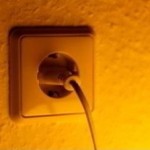
A low-cost, plastic solar lamp could provide affordable lighting for millions living in rural off-grid areas across Africa.
The lamp is made from polymer solar cells and although it is not as efficient as similar technologies, it could prove more affordable, according to its developers.
“There are many technologies out there already that are established and better performing but perhaps these do not have the potential to go much lower in cost,” said lead researcher Frederik Krebs, from the Risø National Laboratory for Sustainable Energy, in Denmark.
Several versions of the lamp are under development, following trials on a prototype in Zambia in 2009. One, a pocket-sized torch that could be used for night-time navigation, is ready to be rolled out commercially and Krebs is confident that it could be produced for as little as €3 (around US$4).
He suggested that ‘microfinance’ schemes, where people collaborate to buy a lamp which they can share, would be useful for people who cannot afford this initial outlay.
David Grimshaw, Head of the International Programme on New Technologies at Practical Action – a UK-based charity that uses technology to challenge poverty – welcomed this research.
“It demonstrates that polymer solar cells can now approach a cost level where they could be adopted by the poor.”
Solar lighting is an important alternative to the kerosene lamps currently used in off-grid developing areas, said David Battley from Charity SolarAid, based in the United Kingdom, which promotes the use of solar energy to help reduce global poverty and climate change. Kerosene lamps are a fire hazard, release damaging fumes, and place a financial burden on the user who constantly has to buy fuel.
“The availability of essentially free lighting – after the point of initial purchase – has massive benefits to both health and education,” said Battley. “It should be absolutely sustainable, so it’s not dependent on Western funding.”
The field trials allowed researchers to improve subsequent versions of the lamp by identifying the problems users encountered. For example, some people mistakenly charged the lamp upside down, reducing efficiency. Others charged it in front of a campfire and accidentally destroyed the solar cell.
“The way we intended for the user to handle it was perhaps not the way the user perceived the object,” said Krebs.
Grimshaw said that this field testing is an important part of the design process. “Such an engagement process is much more likely to improve the uptake of the scientific innovation.”
The lamp was developed as part of the ‘Lighting Africa’ Initiative, established by the World Bank, which promotes sustainable lighting solutions for Africa.














